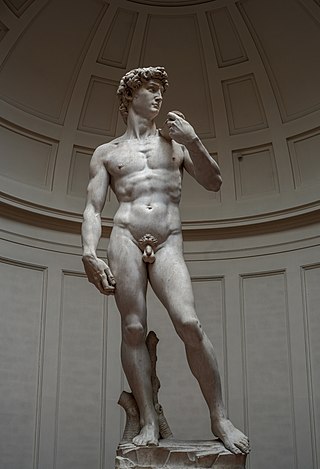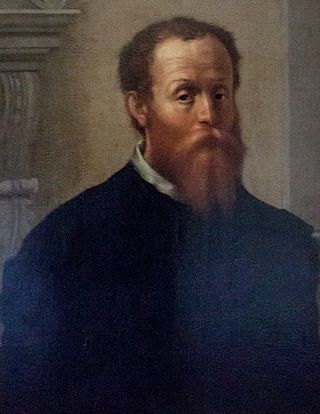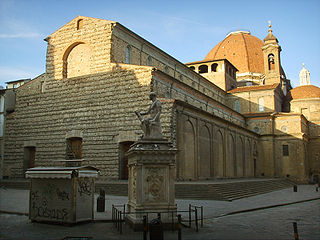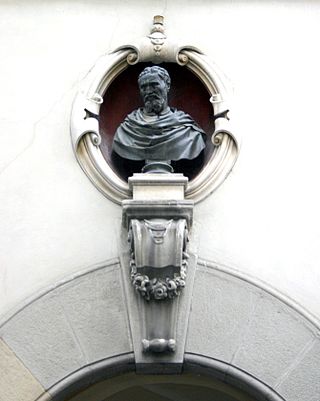Related Research Articles

Michelangelo di Lodovico Buonarroti Simoni, known mononymously as Michelangelo, was an Italian sculptor, painter, architect, and poet of the High Renaissance. Born in the Republic of Florence, his work was inspired by models from classical antiquity and had a lasting influence on Western art. Michelangelo's creative abilities and mastery in a range of artistic arenas define him as an archetypal Renaissance man, along with his rival and elder contemporary, Leonardo da Vinci. Given the sheer volume of surviving correspondence, sketches, and reminiscences, Michelangelo is one of the best-documented artists of the 16th century. He was lauded by contemporary biographers as the most accomplished artist of his era.

David is a masterpiece of Italian Renaissance sculpture, created from 1501 to 1504 by Michelangelo. With a height of 5.17 metres, the David was the first colossal marble statue made in the early modern period following classical antiquity, a precedent for the 16th century and beyond. David was originally commissioned as one of a series of statues of twelve prophets to be positioned along the roofline of the east end of Florence Cathedral, but was instead placed in the public square in front of the Palazzo della Signoria, the seat of civic government in Florence, where it was unveiled on 8 September 1504. In 1873, the statue was moved to the Galleria dell'Accademia, Florence, and in 1910 replaced at the original location by a replica.

The Madonna della Pietà, informally known as La Pietà, is a marble sculpture of Jesus and Mary at Mount Golgotha representing the "Sixth Sorrow" of the Blessed Virgin Mary by Michelangelo Buonarroti, now in Saint Peter's Basilica, Vatican City. It is a key work of Italian Renaissance sculpture and often taken as the start of the High Renaissance.

The Sistine Chapel is a chapel in the Apostolic Palace, the pope's official residence in Vatican City. Originally known as the Cappella Magna, the chapel takes its name from Pope Sixtus IV, who had it built between 1473 and 1481. Since that time, the chapel has served as a place of both religious and functionary papal activity. Today, it is the site of the papal conclave, the process by which a new pope is selected. The fame of the Sistine Chapel lies mainly in the frescoes that decorate the interior, most particularly the Sistine Chapel ceiling and The Last Judgment, both by Michelangelo.

Baccio Bandinelli, was an Italian Renaissance sculptor, draughtsman, and painter.

The Pietà is a subject in Christian art depicting the Blessed Virgin Mary cradling the mortal body of Jesus Christ after his Descent from the Cross. It is most often found in sculpture. The Pietà is a specific form of the Lamentation of Christ in which Jesus is mourned by sole privilege of the Virgin Mary alone, whilst representing her "sixth sorrow" and sometimes accompanied by a specific Marian title.

The Basilica di San Lorenzo is one of the largest churches of Florence, Italy, situated at the centre of the main market district of the city, and it is the burial place of all the principal members of the Medici family from Cosimo il Vecchio to Cosimo III. It is one of several churches that claim to be the oldest in Florence, having been consecrated in 393 AD, at which time it stood outside the city walls. For three hundred years it was the city's cathedral, before the official seat of the bishop was transferred to Santa Reparata.
The Agony and the Ecstasy (1961) is a biographical novel of Michelangelo Buonarroti written by American author Irving Stone. Stone lived in Italy for years visiting many of the locations in Rome and Florence, worked in marble quarries, and apprenticed himself to a marble sculptor. A primary source for the novel is Michelangelo's correspondence, all 495 letters of which Stone had translated from Italian by Charles Speroni and published in 1962 as I, Michelangelo, Sculptor. Stone also collaborated with Canadian sculptor Stanley Lewis, who researched Michelangelo's carving technique and tools. The Italian government lauded Stone with several honorary awards for his cultural achievements highlighting Italian history.

Bastiano da Sangallo was an Italian sculptor, painter and architect of the Renaissance period, active mainly in Tuscany. He was a nephew of Giuliano da Sangallo and Antonio da Sangallo the Elder. He is usually known as Aristotile, a nickname he received from his air of sententious gravity. He was at first a pupil of Perugino, but afterwards became a follower of Michelangelo. Sangallo was mentioned by Vasari as one who made a small copy of the Cartoon of Michelangelo's Battle of Cascina (1506).

Antonello Gagini (1478–1536) was an Italian sculptor of the Renaissance, mainly active in Sicily and Calabria.

Bacchus (1496–1497) is a marble sculpture by the Italian High Renaissance sculptor, painter, architect and poet Michelangelo. The statue is somewhat over life-size and represents Bacchus, the Roman god of wine, in a reeling pose suggestive of drunkenness. Commissioned by Raffaele Riario, a high-ranking Cardinal and collector of antique sculpture, it was rejected by him and was bought instead by Jacopo Galli, Riario's banker and a friend to Michelangelo. Together with the Pietà, the Bacchus is one of only two surviving sculptures from the artist's first period in Rome.

Hercules and Cacus is an Italian Renaissance sculpture in marble to the right of the entrance of the Palazzo Vecchio in the Piazza della Signoria, Florence, Italy.

Bertoldo di Giovanni was an Italian Renaissance sculptor and medallist.
Raffaello da Montelupo, born Raffaele Sinibaldi, was a sculptor and architect of the Italian Renaissance, and an apprentice of Michelangelo. He was the son of another Italian sculptor, Baccio da Montelupo. Both father and son are profiled in Vasari's Le Vite delle più eccellenti pittori, scultori, ed architettori.

Michelangelo is a 230 km diameter impact basin in the Michelangelo quadrangle of Mercury, which is named after this crater. The crater itself was named by the IAU in 1979 after the Italian painter, sculptor and architect Michelangelo.
The Titan: Story of Michelangelo is a 1950 German documentary film about the painter and sculptor Michelangelo. It won the Academy Award for Best Documentary Feature.

Casa Buonarroti is a museum in Florence, Italy. The building was a property owned by the sculptor Michelangelo, which he left to his nephew, Leonardo Buonarroti. The house was converted into a museum dedicated to the artist by his great nephew, Michelangelo Buonarroti the Younger. Its collections include two of Michelangelo's earliest sculptures, the Madonna of the Stairs and the Battle of the Centaurs. A ten-thousand book library includes the family's archive and some of Michelangelo's letters and drawings. The Galleria is decorated with paintings commissioned by Buonarroti the Younger and created by Artemisia Gentileschi and other early seventeenth-century Italian artists.

Battle of the Centaurs is a relief sculpture by the Italian Renaissance artist Michelangelo, created around 1492. It was the last work Michelangelo created while under the patronage of Lorenzo de' Medici, who died shortly after its completion. Inspired by a classical relief created by Bertoldo di Giovanni, the marble sculpture represents the mythic battle between the Lapiths and the Centaurs. A popular subject of art in ancient Greece, the story was suggested to Michelangelo by the classical scholar and poet Poliziano. The sculpture is exhibited in the Casa Buonarroti in Florence, Italy.

The Rothschild Bronzes, also known as the Michelangelo Bronzes, are a pair of 16th century statuettes, each depicting a nude male figure riding a mythological animal, usually identified as a panther. Mirroring each other in pose, the nude men are distinguished by age, one young, the other bearded. The younger man is 76.6 cm, the other almost 90 cm high. The sculptures are unsigned and the figures and panthers have been separately cast. The bronzes were displayed to the public at the Fitzwilliam Museum, University of Cambridge, from February to August 2015 with an attribution to Michelangelo. If the attribution is correct, Michelangelo would have made the bronzes around 1506 to 1508, before the painting of the Sistine Chapel ceiling but after the marble statue of David. The sculptures would be the only autograph bronze works by Michelangelo to have survived.
References
- ↑ "Meet Fakeero Solanki Michelangelo of Sindh". Lahore Herald.
- ↑ "Inside the fascinating studio of Sindh's Michelangelo". The Express Tribune. February 6, 2021.
- 1 2 Ahmed, R. Umaima (September 21, 2020). "Fakeero Solanki — the pride of Sindh | Sabaat".